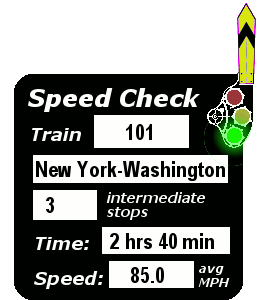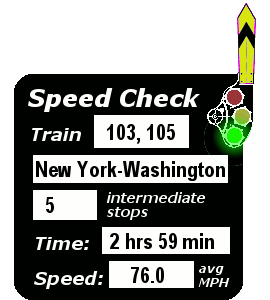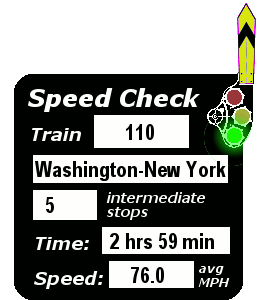NEW
YORK - WASHINGTON
EQUIPMENT
No.
101—Metroliner
Mondays thru Fridays.Metroclub
Car (Meals and Beverages served at seats.)
Metro Snack Bar
Coach.
No. 103—Metroliner
Daily.Metroclub
Car (Meals and Beverages served at seats.)
Metro Snack Bar
Coach.
No. 105—Metroliner
Daily.Metroclub
Car (Meals and Beverages served at seats.)
Metro Snack Bar
Coach.
No. 107—Metroliner
Daily.Metroclub
Car (Meals and Beverages served at seats.)
Metro Snack Bar
Coach.
No. 109—Metroliner
Daily.Metroclub
Car (Meals and Beverages served at seats.)
Metro Snack Bar
Coach.
No. 111—Metroliner
Mondays
thru Fridays.Metroclub Car (Meals and
Beverages served at seats.)
Metro Snack Bar Coach.
For
purchase of tickets on Metroliners between Newark and Trenton, consult
Ticket Agent at Newark or Trenton.WASHINGTON
- NEW YORK
EQUIPMENT
No.
100—Metroliner
Mondays thru Fridays.Metroclub
Car (Meals and Beverages served at seats.)
Metro Snack Bar
Coach.
No. 102—Metroliner
Daily.Metroclub
Car (Meals and Beverages served at seats.)
Metro Snack Bar
Coach.
No. 104—Metroliner
Daily.Metroclub
Car (Meals and Beverages served at seats.)
Metro Snack Bar
Coach.
No. 106—Metroliner
Daily.Metroclub
Car (Meals and Beverages served at seats.)
Metro Snack Bar
Coach.
No. 108—Metroliner
Daily.Metroclub
Car (Meals and Beverages served at seats.)
Metro Snack Bar
Coach.
No. 110—Metroliner
Mondays
thru Fridays.Metroclub Car (Meals and
Beverages served at seats.)
Metro Snack Bar Coach.
For
purchase of tickets on Metroliners between Newark and Trenton, consult
Ticket Agent at Newark or Trenton.METROLINER
RESERVATIONS
Any Penn
Central ticket office will be glad to arrange your Metroclub Car
reservations. Please make your reservations as much in advance as
possible.
If your plans change, please cancel your
reservations promptly.
Telephone numbers for Metroclub Car
reservations in principal cities are listed at right.
Coach
seats on Metroliners are not reserved, but tickets must be purchased in
advance of departure.















The Japanese Shinkansen "bullet trains" had been introduced to the world in 1964. In 1965, with the passage of the High Speed Ground Transportation Act, the U.S. also put a toe into the world of high speed railroading. A Department of Transportation-backed consortium which included the Pennsylvania Railroad and the Budd company as well as Westinghouse and General Electric took on the ambitious task of designing a modern high-speed rail service, intended to operate between New York and Washington at speeds up to 160 miles per hour. The new service was intended to make its debut in 1967—but production delays and other setbacks pushed the initial introduction of the first Metroliner back to January of 1969.
See a scanned copy of the Penn Central's PC Post with a feature article on the new Metroliners.